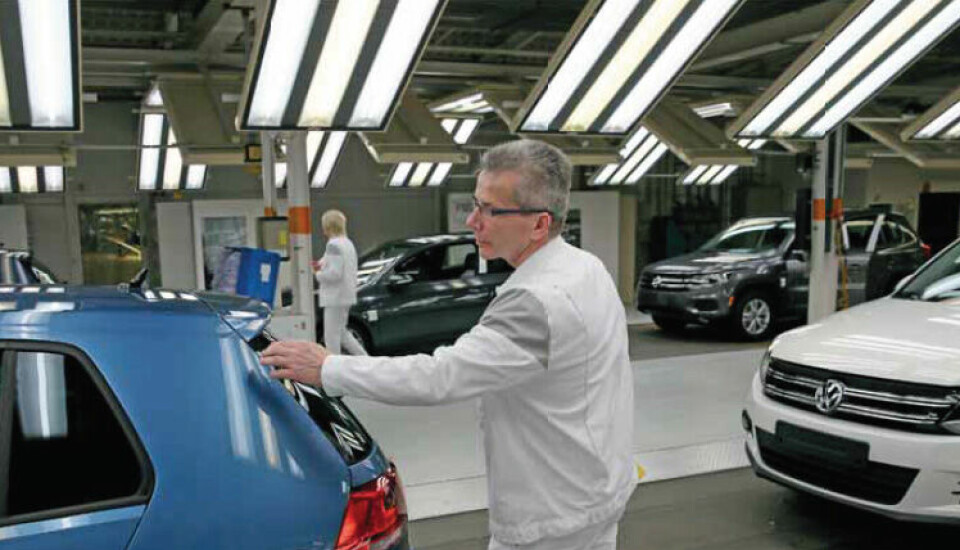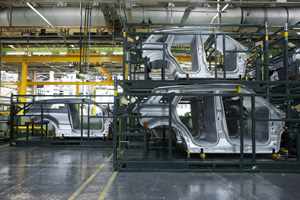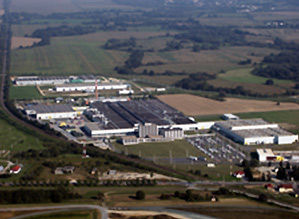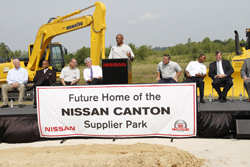Logistics and outsourced labour
Thousands of outsourced logistics workers will stage a symbolic mini-strike against DHL and Jaguar Land Rover in a protest against pay and the use of contracted labour. Is it a sign of greater risks in the supply chain?

The dispute that has simmered this summer in the UK between Unite, the country’s largest union, and DHL Supply Chain over the wages and benefits of logistics workers serving Jaguar Land Rover plants will not quite heat to a boil next week, when parts handlers will stage a very short strike. After workers voted for industrial action across plants and logistics centres this summer, including a ballot of agency staff, Unite has served notice that the workers will walk out for 30 minutes on August 28th, the legal deadline for strike action.
The move is barely enough to impact production, and is largely a symbolic gesture to demonstrate its disagreement with DHL's current pay offer. Talks are set to continue this week.
While the conflict is specific to the two companies, it raises wider questions over outsourcing and labour flexibility in a post-recession (at least for some countries) but still uncertain automotive industry, and the role that logistics services are playing in them.
The JLR-DHL contract, perhaps more than other ‘lead logistics provider’ partnerships of its kind, has redrawn labour lines in the supply chain. Since 2009 DHL has had control of almost all of JLR’s inbound transport and parts-handling labour, including consolidation, warehouse management, container handling, sequencing, kitting and line feeding. Upstream at warehouses and logistics centres, DHL has subcontracted some of this labour, with agencies providing workers who are paid less and have fewer guarantees for holiday and redundancy pay than a DHL or JLR employee. The result, in at least some cases, is that there are workers doing essentially the same job but with three different tiers of pay, benefits and protection.
This divide-and-contract approach is not unheard of for automotive supply chains, although the JLR-DHL example does go further than some manufacturers both to the extent of labour outsourcing as well as in single sourcing so much with one logistics provider. Traditionally, the plant dock has stood as an unofficial border between a manufacturer’s labour and that of its suppliers, at least in the view of many unions. However, it is a line that carmakers and suppliers have beaten back regularly over the past decade, and are still reshaping today.
For example, General Motors, Volkswagen and Daimler have all used third party labour to handle parts at some of their plants. In the US, Nissan has had tier suppliers based within its factories. While such outsourcing is more common where it is easier to get around union membership, such as the American south, Mexico and eastern Europe, it has increasingly been done in areas where unions are stronger, such as Michigan, the UK and in Germany.
Such changes are just a small symptom of a macroeconomic trend for more labour flexibility on both sides of the Atlantic. In Britain, there has been controversy this summer following revelations about a higher-then-estimated use of ‘zero hours’ contracts in the retail sector, which offer no guaranteed hours. Amazon has come under fire in the UK and Germany for using warehouses filled mostly with temporary and agency staff. Ver.di, a German union for the service sector, is pushing the online retailer to reclassify its warehouse workers as retail employees rather than logistics, which would mean about €9,000 ($12,000) more per year for each, according to the union.
Not the Werk it used to be
While there have been complaints about similar labour practices in the car industry, it has been overshadowed by the sector’s wider growth story of late, especially in the US and the UK. According to the US Bureau of Labor Statistics, the automotive industry had added more than 260,000 jobs as of January this year since its low point in June 2009, a rise of 16%.
In UK, about 10,000 new jobs in automotive have been created each year, according to the Automotive Council UK. JLR, for example, is currently recruiting around 1,100 staff for a new engine plant and has been hiring management positions as well, including for logistics. The company announced 100 new purchasing positions last week.
But the headline job figures tend to include a large amount of temporary workers, with automotive companies cautious about overinvesting in capacity or labour. Instead, manufacturers, suppliers and providers have looked increasingly towards outsourced labour and redesigned workflows in plants and the wider supply chain. Earlier this year, Ford told Bloomberg that it had increased the amount of temporary staff it uses in the US by 11% this year.
In Germany, reforms more than a decade ago ushered in a huge rise in both temporary workers and those on fixed-term contracts (known in Germany as a Werkvertrag), which have increased partly at the expense of union membership. IG Metall, a union representing metal and electronics workers in Germany, says that it has observed a growing number of contracted as well as temporary staff in the automotive industry. Christian Plaep, a spokesperson, estimates that there are about 100,000 temporary workers in the German automotive sector.

In Germany, some car factories use contracted workers for up to 50% of the labour
He admits that precise data are unreliable for contracted labour services, however a recent survey of 5,000 union committeemen revealed that a third of the companies they represent use contracted workers, including a large amount in automotive.
“In the [German] steel industry 8% of the employees have a Werkvertrag,” Plaep tells Automotive Logistics. “In the German automobile industry, we have plants where 50% of the people have a Werkvertrag. And mostly, those people earn less for the same work as regular employees.”
Contracted and temporary workers are employed across all elements of production. However, IG Metall also notes a growing tendency towards logistics companies taking on jobs in the German automotive industry. As with JLR and DHL, these workers sometimes work side by side with those on full contracts but have different pay and conditions.
Temporary growth could be a permanent problem
Outsourcing has long been important to the automotive industry, particularly for buying knowledge or adding flexibility. Over the years the third party logistics industry has increasingly offered specialised services, IT and equipment in areas arguably outside a manufacturer’s core focus, whether in consolidation networks or parts sequencing. Such providers have also increasingly built up skills or acquired companies to take on more manufacturing-related services, including module assembly, which allow OEMs to lower parts inventory and use more just-in-time production techniques.
However, Plaep argues that the outsourcing target today has less to do with adding value and more to do with pure cost reductions, which is why there are so many more temporary and agency workers. “Companies are trying to avoid the union rates that had been negotiated before,” he says.
But with sustained growth in some parts of the automotive industry, workers and unions are challenging the degree to which labour terms and conditions should vary on either side of the increasingly thin lines that separate them in plants and warehouses. Plaep says that IG Metall has recently negotiated new labour agreements for temporary workers that included higher pay, while it is also running large campaigns to push for new agreements and legislation for fixed-term contracts.
In the US, negotiations for the next contract for the automotive workers’ union, the UAW, could target the use of agency and temporary workers, including those used by logistics providers. In a potentially illustrative example, GM recently absorbed the in-plant logistics labour at one Michigan plant, which it had previously outsourced to a 3PL, into a subsidiary. The subsidiary’s employees, however, appear to have different labour terms and conditions than other UAW-GM workers.
 Although the 30-minute strike by logistics workers is unlikely to impact production, any further action could have disrupted production in a matter of hours
Although the 30-minute strike by logistics workers is unlikely to impact production, any further action could have disrupted production in a matter of hoursIn the UK, a wider strike against DHL would have hit JLR production at a time when the carmaker can barely build cars fast enough to keep up with demand. For now at least, wider changes appear likely to be avoided to labour terms and conditions as well as to the way JLR outsources its logistics. But the unrest is unlikely to be forgotten, and follows similar pay disputes with Unite last year. DHL has warned that such action could jeopardise future expansion with JLR.
The symbolic and relatively harmless gesture by Unite is perhaps a sign of the difficulty the union faces. One argument for the increased competitiveness for companies like JLR in the UK has been the use of fairly cheap and flexible labour, and that major changes to this could threaten the production base. That might be overstating the case when it comes to parts-handling and logistics, although the Tata Motors-owned carmaker is building plants abroad already, including a joint venture factory in China set to open next year. JLR will only say now that it urges Unite and DHL to resolve the dispute before it "impacts our growing UK output and investment plans". In any case, despite the recent growth in both the US and UK, labour flexibility is increasingly a structural demand for many manufacturers, and they are likely to go on using it, including through logistics outsourcing.
From supply chain decline to the sublime
Indeed, the JLR-DHL contract has made use of supply chain flexibility par excellence during both crisis and growth modes. When it was signed in 2009, JLR was close to its lowest ebb, with at least one plant slated for closure. DHL took over a supply chain expected to shrink in volume. Thomas Cullen, senior analyst at Transport Intelligence, a logistics consultancy, says that at the time of the deal JLR was so “desperately” under-capitalised that it needed DHL’s “injection of resources” in the supply chain.
JLR’s UK production would go on to nearly treble in a few years, with the company now investing billions in the UK and European supply base to support model launches. Knockdown-kit assembly has grown abroad, driving up parts exports and imports, which should increase further with the opening of the China plant next year. In almost all areas, demand for logistics has risen above expectations. DHL says that it has added 2,500 jobs in the Midlands and Merseyside, which are close to JLR plants, since 2011 (it does not specify the proportion of that which has been filled by agencies, however).
DHL has needed to move fast to keep up, and JLR executives previously told Automotive Logistics that the provider has been vital to the carmaker’s expansion. Last year, for example, when JLR took over a warehouse from Vauxhall close to Ellesmere Port, DHL had less than two months to get the site fully staffed and operational. Ellesmere Port is apparently among the DHL facilities employing a high number of agency workers.
Outsourcing labour in this way helps JLR and DHL avoid certain labour terms and conditions, says Cullen. As well as redundancy pay, he points out that, with JLR running its plants at nearly 24 hours per day, full-time staff would have the chance to earn considerable overtime pay, while temporary or semi-temporary would get less or none.
 JLR logistics management has said that the DHL contract has allowed for a great deal of flexibility in both its transport and logistics centre operations
JLR logistics management has said that the DHL contract has allowed for a great deal of flexibility in both its transport and logistics centre operationsThat is part of the reason why Unite, along with higher pay (over two years it wants more than 12% for logistics workers and more than 20% for drivers), wants more agency workers on permanent contracts. DHL has apparently increased its pay offer to 6.2% in 2013 and an inflation-linked rise next year of at least 3% next year for all logistics workers. The company claims it has increased wages by more than 15% for logistics workers since 2011, however this increase does not appear to have included the agency workers.
Negotiations will continue this week.
Just can't keep them apart
Given the near hit on JLR's production, are there risks and lessons to consider for the rest of the automotive industry? It’s first worth pointing out that JLR is particularly exposed because of the single-source contract with DHL. Likewise, few carmakers have put so much of its network’s parts handling into outside hands. For example, the outsourcing of line feeding and in-plant materials handling is still a step too far for a number of manufacturers. Cullen points out that it doesn’t exist in any Toyota plants, for example.
Representatives from GM say the company usually doesn’t outsource such activities, although they don’t rule it out. Crystal Wilson, a spokesperson for General Motors, says that GM employees under UAW contracts handle all plant dock operations in the US, and most often in-plant logistics as well. “If a third party is involved, it is typically only supplier management personnel – salaried staffing – that would be outsourced,” she says.
An official at Opel/Vauxhall, GM’s European unit, says that material handling activities are traditionally considered as “core for the supply chain [team] and kept in-house.”
Having logistics centres close to plants is a more common way for carmakers to outsource parts handling such as kitting and sequencing, as well as for module assembly. However, while IG Metall’s Plaep says most materials handling-related outsourcing happens outside plants, there is a growing amount of ‘on-side’ or in-plant work done by providers, including temporary and contracted workers. The Schnellecke Group, a German logistics provider that has also acquired module assembly operations, has done line-feeding operations at a number of Volkswagen Group plants, including Mosel and Dresden in Germany, and Puebla in Mexico. DB Schenker has performed line feeding for Volkswagen’s Transporter plant in Hanover. In the UK, DHL also does line feed for Bentley.
 At its powertrain plant in Szentgotthard, Hungary, Opel has outsourced parts receiving, storage and line feeding to a logistics provider
At its powertrain plant in Szentgotthard, Hungary, Opel has outsourced parts receiving, storage and line feeding to a logistics providerAnd despite generally keeping it in-house, Opel/Vauxhall also uses providers in some instances for receiving, storage and line feeding. In an echo of the JLR-DHL arrangement, Opel has sometimes even concentrated all these services in one hand, such as at its powertrain plant in Szentgotthard, Hungary, says the official, who does not wish to be named.
Daimler, likewise, has outsourced parts receiving and line feed to Kuehne and Nagel at its Mercedes-Benz plant in Kecskemet, Hungary. And while such outsourcing is rare for General Motors in the US and Canada, some of the carmaker’s Mexico plants have suppliers providing both management and hourly workers for third party operations, confirms Wilson.
Bringing some of it back home
However, there is evidence of some carmakers pulling back from this kind of outsourcing. According to Michael Robinet, managing director of IHS Automotive Consulting, logistics has become more of a cost factor for carmakers, particularly with manufacturing increasingly shared across global platforms. With the emphasis on controlling the associated costs and risks, he sees more instances of manufacturers reducing logistics outsourcing.
"A major topic in the industry is the constant drumbeat of OEMs seeking lower logistics costs and the inherent reduced risk which results," he says. "Controlling logistics is a key differentiator and thus OEMs are bringing this back in house.
GM seems to have shifted in this direction at least for its material handling and in-plant logistics. “Circumstances and requirements can change over time,” the Opel official tells Automotive Logistics. “The most recent development [for Opel/Vauxhall] is suggesting that we keep services such as material handling, sequencing and business malls in-house.”
This emphasis on keeping such services in-house is interesting since GM has recently outsourced much of its transport management in Europe to Gefco. However, the official confirms that Opel/Vauxhall management rather than Gefco will continue to coordinate such in-plant services, as well as module assemblers.
"Circumstances and requirements can change over time. The most recent development is suggesting that we keep services such as material handling, sequencing and business malls in-house" - Offical, Opel/Vauxhall
There also appears to have been some change in thinking around outsourcing in-plant logistics for GM in the US. An interesting example is the Lake Orion, Michigan plant where, until recently, hourly labourers from a logistics provider worked inside the plant alongside UAW-GM employees.
Just as Unite reached agreements with JLR following the financial crisis to make labour more flexible, the UAW and GM reached a number of accords, including one in 2009 that saved Orion from closure and helped bring production of the Chevrolet Sonic there from South Korea. Firstly, the union allowed the plant to hire a higher percentage of workers on ‘tier two’ wages (the lower rate of pay for new hires, which the carmakers negotiated with the unions in 2007). But it also agreed to allow a logistics provider, Linc, work in the plant to do kitting, sequencing and some parts-store management. The result, as in the JLR-DHL example, was a three-tier wage structure. Workers at the plant are not immediately distinguishable between the different groups, as they often work side by side.
The Orion plant is an interesting microcosm for the economic pressures in a globalised automotive industry. As Orion builds a subcompact car – the only one currently assembled in the US – it competes on costs with plants in Mexico and Asia. It also has a supply chain of many foreign parts, including modules and kits from Korea. Along with higher transport costs, more of the parts-handling work at the plant might be called ‘logistics’ rather than ‘manufacturing’. The kitting area takes up a large amount of space on the factory floor, for example, which makes Orion look somewhat like a hybrid between a plant and a warehouse.
This arrangement is arguably part of what kept the plant open and a success story. The Sonic is among the best selling cars in its class, while
 GM has brought previously outsourced in-plant logistics at its Orion plant back in-house to a subsidiary
GM has brought previously outsourced in-plant logistics at its Orion plant back in-house to a subsidiaryPresident Barack Obama has even visited the factory. But there is no denying that balancing the different companies and wages under the same roof had been tricky. According to local reports, there had been protests at the factory as Linc employees – which also included a number of temporary workers – campaigned for higher pay. Turnover was reportedly high.
GM and Linc now confirm that the situation has changed, with GM having taken the hourly labour back in-house – sort of. According to Wilson, the GM spokesperson, GM Subsystems Manufacturing, a wholly owned subsidiary, now does kitting and sequencing at Orion. The UAW represents the workers for the subsidiary.
Linc, which was taken over last year by Universal Truckload Services, still manages the processes using its own management and technology. “Our Linc subsidiary still manages the processes at Lake Orion Assembly using our technology,” says David Crittenden, chief financial officer for Universal Truckload Services. “However, our customer decided to direct-employee the hourly workers involved.”
Crittenden says that agreements with GM prevent him from commenting further, while Wilson says that GM cannot currently give more details on the decision or the subsidiary. The first mention of GM Subsystems Manufacturing appears to be in 2009, when GM converted a warehouse in Brownstown Township to a battery plant and employed people there under the subsidiary. It’s not clear whether GM Subsystems Manufacturing has also maintained the third tier wage for the in-plant logistics workers, however GM told a local television station in Michigan last year that, although the subsidiary has an agreement with the UAW, it is not covered by the UAW-GM national agreement and does not have the same holiday and redundancy terms and conditions.
Know your limits
Will the pendulum for such logistics services eventually swing back in-house at JLR too? Perhaps unsurprisingly, union representatives tend to think that they should. Tony Woodley, a former Unite general secretary who has led the negotiations with DHL, said earlier this summer that JLR was “no longer in control of the destiny of this massively important company because of the outsourcing.”
IG Metall’s Plaep says that carmakers’ reliance on outsourced temporary and contracted workers could lead to a deterioration of staff know-how. “In the short term you might be reducing costs, but in the long term you are losing skills and knowledge, and that can be much more expensive than the costs you’ve saved,” he says.
"In the short term you might be reducing costs, but in the long term you are losing skills and knowledge, and that can be much more expensive than the costs you've saved" - Christian Plaep, IG Metall
JLR is not making any comment on such a move for now, beyond hinting at risks to UK investment. While any immediate insourcing of this logistics work appears unlikely, taking the work back in-house or moving it to another LLP would not necessarily change these complicated dividing lines between pay and benefits. Transport Intelligence’s Cullen suggests that this dilemma might even represent a limit to what a manufacturer or ‘lead logistics provider’ can do in such far-reaching contracts. “As soon as you start doing projects as specific as this, you incur more costs,” he says.
In future, JLR could consider dividing its inbound logistics between more logistics providers.
 Nissan, GM and Mercedes-Benz are among the carmakers building new logistics centres at plants in the US
Nissan, GM and Mercedes-Benz are among the carmakers building new logistics centres at plants in the USDevelopments in the US could point to something of a middle ground for outsourcing materials handling, at least. A number of manufacturers are increasingly building logistics centres onto the plant complex itself. These centres, which are often staffed by logistics providers, help reduce transport costs but also provide labour flexibility by moving parts sorting and sequencing outside the assembly hall. Toyota now uses sorting centres at or near to several of its North American plants, for example, including one on the grounds of its Georgetown, Kentucky factory, where a 3PL supplies the labour but uses Toyota processes and technology. Parts are delivered to the assembly and engine plant docks next door, which are in turn staffed entirely by Toyota.
Nissan has recently broken ground on a large logistics centre on the campus of its Mississippi plant, while GM is also building a logistics centre next to its Cadillac plant in Lansing, Michigan, which will perform parts sequencing. Mercedes-Benz is currently building a new logistics centre at its plant in Alabama that will use both Mercedes staff and logistics providers to handle parts.
The factors driving such investments include both reducing shipping costs but also much wider savings, from tooling investments to supply risk and indeed, labour. Regardless of any further agreements that DHL and Unite reach, economic and competitive pressures are likely to still lead automotive companies to outsource labour to providers and agencies, although the amount could well vary and future changes to JLR's approach to logistics outsourcing should not be ruled out.
That logistics providers are increasingly part of those strategies shows the competitive advantage that supply chain management can play in the car industry’s renewed growth in the US and parts of Europe. But the pushback and resentment from workers should be a real consideration, as it could threaten not only the likes of JLR or GM, but also the logistics companies caught in the crossfire.





